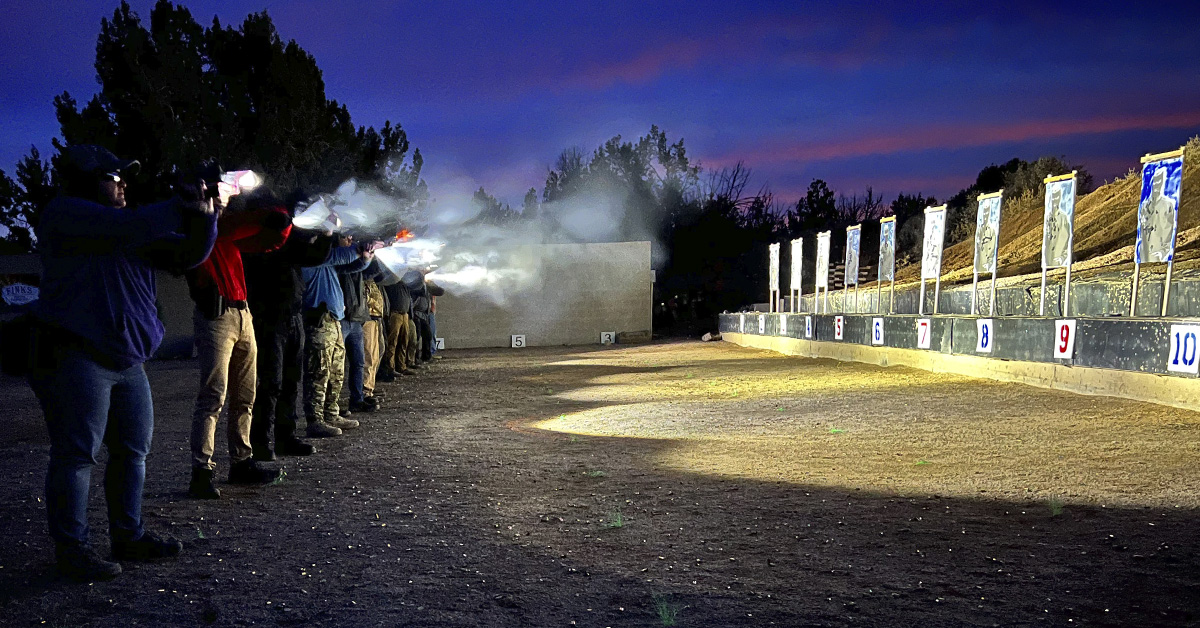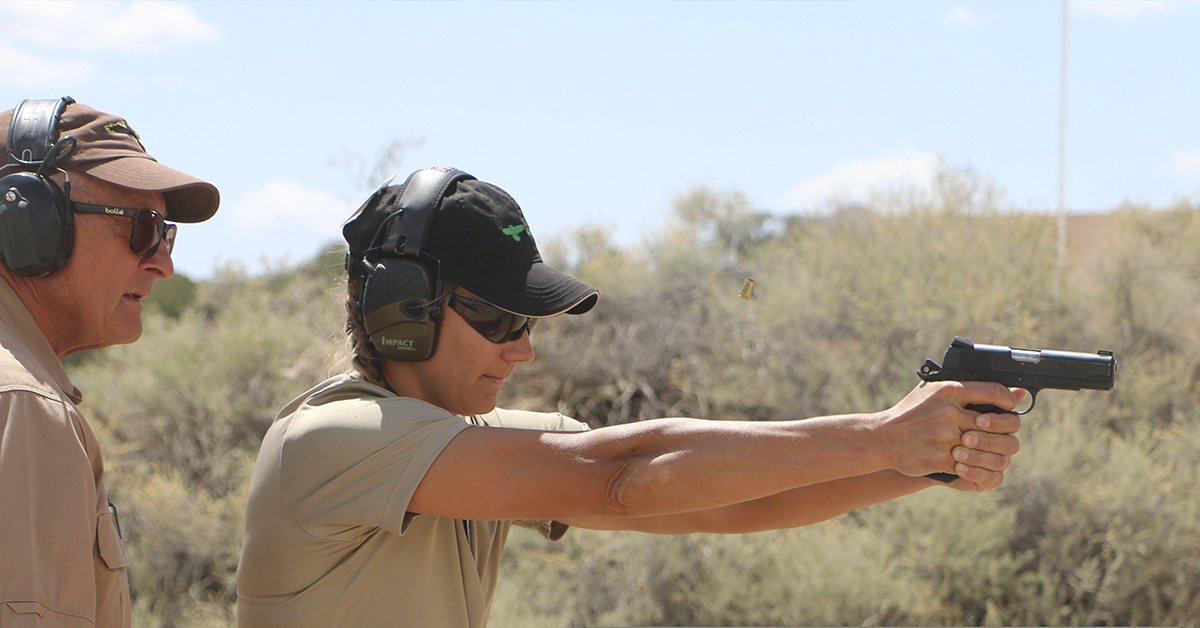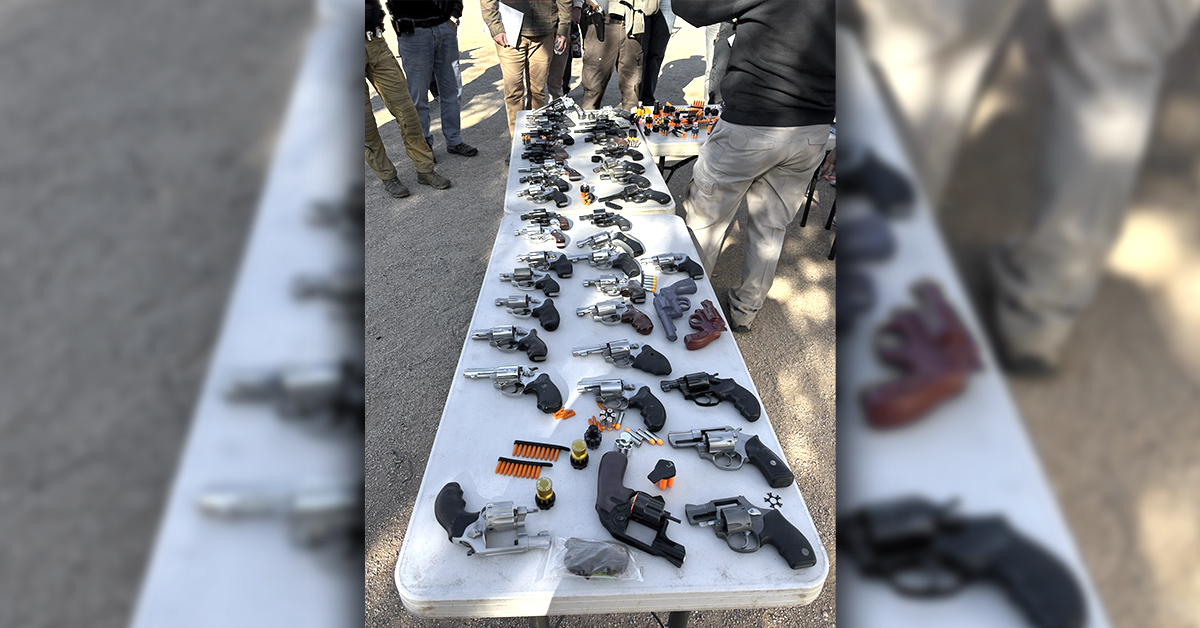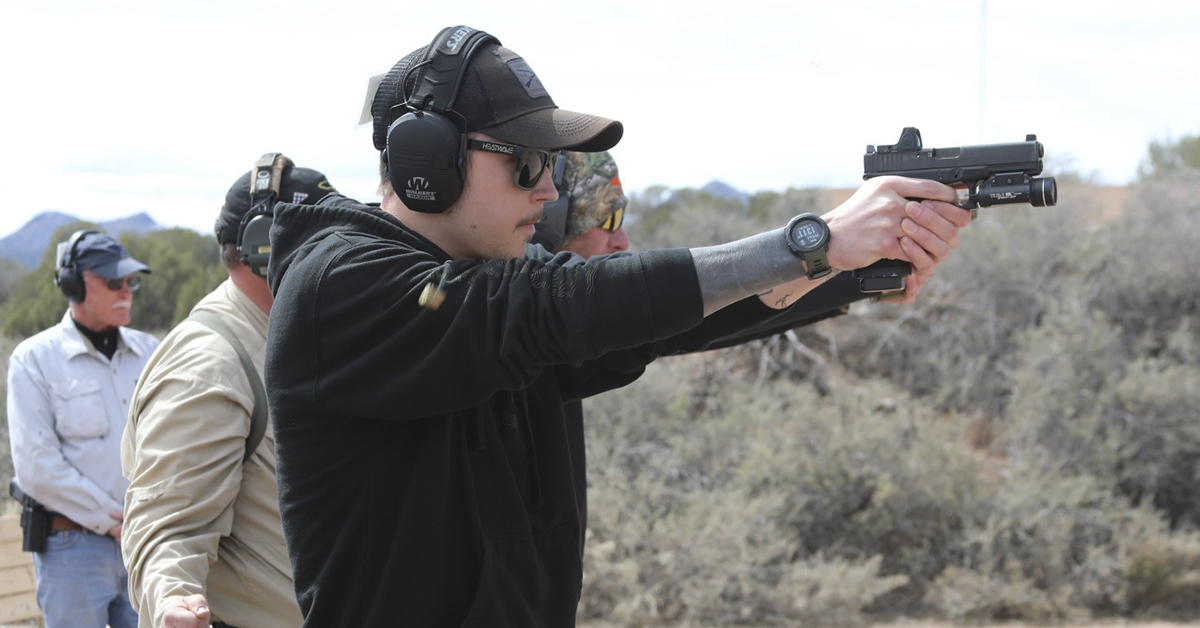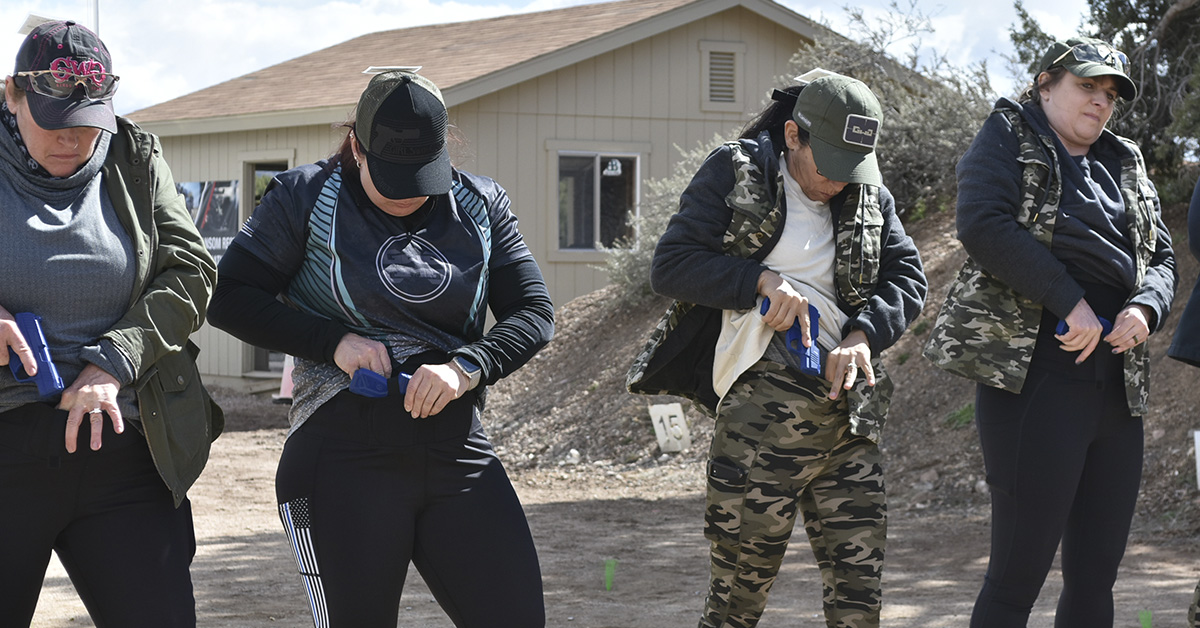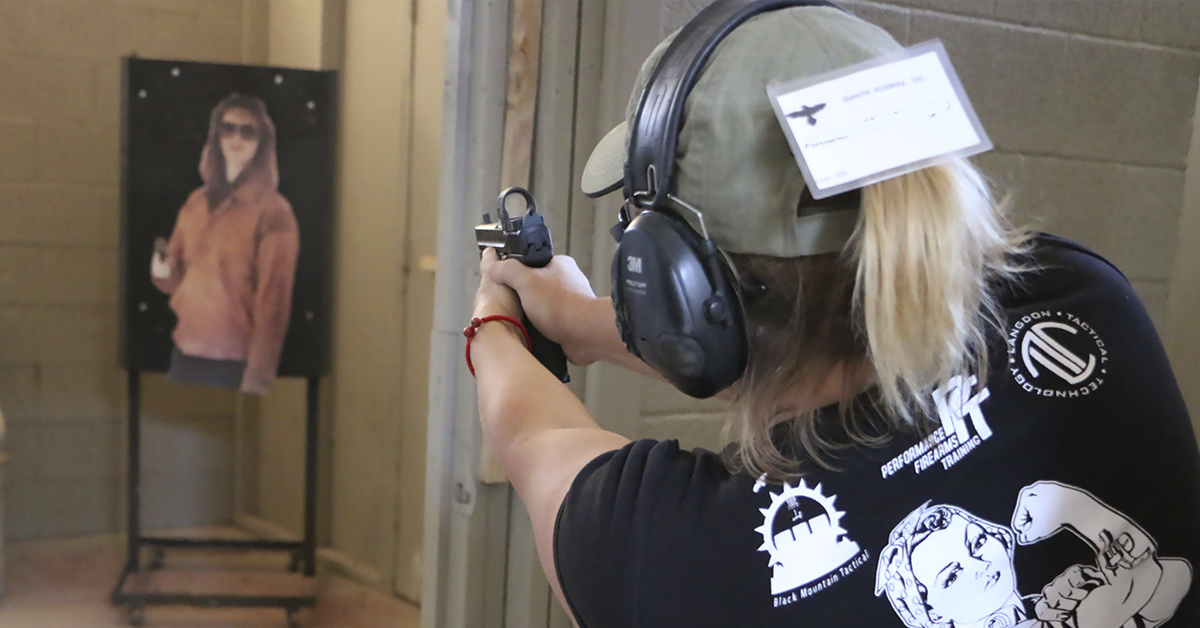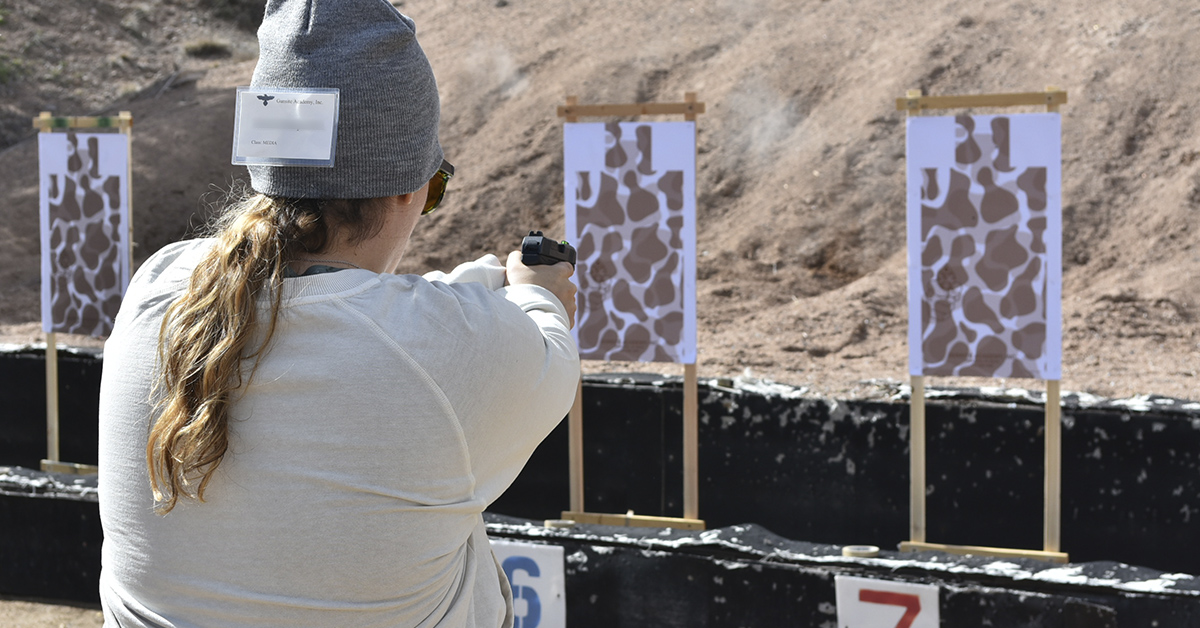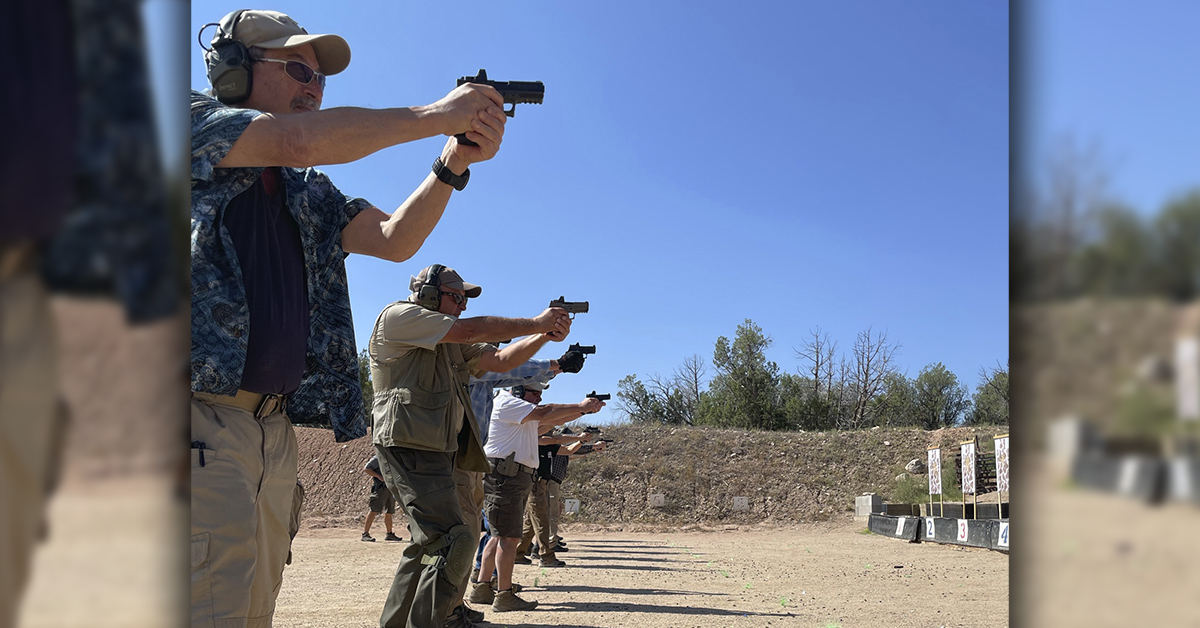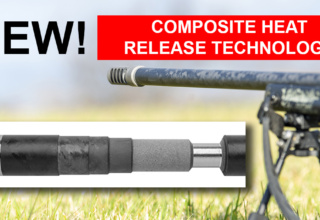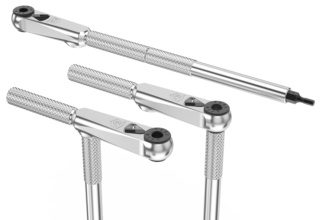For the third installment of our Trainers Talk series, we examine defensive handgun instruction and equipment with Gunsite Academy instructor Steve Tarani
by the Shoot On staff
There is no question that the handgun is the dominant firearm for personal defense. While the shotgun and carbine rifle certainly have their place in a personal/home defense arsenal (as we discussed in Part One and Part Two of our Trainers Talk series), the handgun — revolver or semi-auto pistol — delivers many advantages for the practiced and competent shooter, which is why handguns lead the popularity ranking of personal defense weapons.
Much of the reason behind that is practicality. The smaller handgun footprint makes it the most viable choice for everyday carry, the only choice for concealed carry, and in close-quarter urban environments, it is often the most pragmatic choice. Handguns are easily stored, highly mobile for daily life, and in the hands of a properly trained shooter, highly effective in neutralizing dangerous threats.
The emphasis here, though, is on the “properly trained” qualifier. Handguns can certainly get the job done, but the attributes that give them their advantages — portability, concealability, ample firepower, and effectiveness in the typical close-quarter defensive scenarios — also demand a baseline skill level of the shooter that, some may argue, exceeds that of the shotgun or carbine. In short, it usually takes more skill to accurately shoot a handgun than a shotgun or rifle.
To the experienced shooter, this is obvious. But the experienced shooter also understands that marksmanship is a set of perishable skills — skills that must be routinely honed to be maintained and rigorously practiced in order to be advanced.
Handguns also insert additional complications into the equation by virtue of their many configurations. With everything from palm-sized semi-autos popping .380 ACP rounds to brutish 8-inch barrel revolvers blasting out .44 Magnum pills, the handgun bench is broad and deep. Finding the right one for your hand size, comfort level, type of carry, and other considerations is essential to successfully employ a handgun for personal defense.
Then there are the support systems that may or may not need to be factored in, such as red dots, lasers, open sight designs, lights, magazine capacities, holster type, et cetera.
For beginner and even moderately experienced handgun shooters, the view can be rather complicated.
To help clear up some of the misunderstandings and confusion, we look to Gunsite Academy — the most respected firearm training center in the U.S.
Established by Lt. Col. Jeff Cooper in 1976, Gunsite employs highly experienced and dedicated instructors to guide students through the pragmatic use of firearms for personal defense based on what the school defines as the Combat Triad: marksmanship, gun handling, and mindset. Gunsite’s course curriculum is extensive, with classes conducted at the academy’s headquarters in Paulden, Arizona, as well as off-site locations in Alabama, Alaska, Colorado, Indiana, Tennessee, and South Carolina.
For this installment of our Trainers Talk Q&A, we have the privilege of discussing a range of defensive handgun topics with Steve Tarani.
A professional educator, author, and keynote speaker, Tarani has served the United States defense, law enforcement, and intelligence communities for over 35 years as a respected subject-matter expert and service provider in protection, firearms, and defensive tactics to high and low-profile federal agencies.
Tarani is a former fulltime Central Intelligence Agency (CIA) protective programs employee and was formerly on staff at the US Department of Energy (DOE) National Security Institute (Security Force Training Department) at Kirtland Air Force Base (NM). He is formerly sworn and is a federally certified firearms instructor who has been on staff at Gunsite Academy for over 20 years and was an adjunct instructor at the SIG Arms Academy (NH) for over 16 years.
Specializing in awareness-based training, Tarani is also the published author of nine books and contributes monthly to numerous firearms industry periodicals. He remains a private-sector protective agent, member of InfraGard, and serves on the National Sheriffs’ Association School Safety and Security Committee.
The Big Picture
SO – Unlike the shotgun or carbine, which may be novel personal defense platforms for many new and experienced shooters alike, the defensive handgun is familiar territory for most of our readers. But familiarity, as we know, does not necessarily translate to proficiency, competency, or having the skill sets necessary for effective defensive use of a handgun. Taking the broad view, what is the single-most important advice you can give to a student or to anyone who intends to use a firearm for personal defense?
STEVE TARANI – In terms of personal defense, pistol calibers are inferior to those of a rifle or shotgun. It is the exact reason why rifles and carbines are utilized as primary weapon systems by military and specialty law enforcement units instead of pistols. In terms of weapon superiority, a pistol is used to get to a rifle; however, as previously mentioned, a rifle is difficult to carry concealed and is not as practical an EDC weapon for most civilians. If it is the case that a handgun is your primary defensive weapon system, then the single-most important advice that a seasoned instructor can provide a student or to anyone who intends to use a firearm for personal defense is to get professional training and maintain your skills.
SO – While Gunsite Academy instructors apply the Combat Triad philosophy across all training courses, are there any large, philosophical differences in your approach to handgun training as opposed to that of a shotgun or carbine?
STEVE TARANI – Think of operating a rifle like driving an eighteen-wheeler and operating a pistol like driving a car. Both vehicles must follow the same rules of the road, including speed limits, traffic lights, and the like, but differ in size, operation, and handling. Handgun training, although sharing identical fundamentals of the Combat Triad mindset, safety, and marksmanship as the long gun, additionally focuses on those gun handling idiosyncrasies specific to the pistol.
The Hardware
SO – Understanding that selecting a handgun is a very personal thing as far as fitment, comfort, and efficient operation, what guidance do you offer someone who is looking to buy a handgun specifically for personal defense? Does this guidance change depending on how the gun will be used (e.g., in the home, open carry, concealed carry, etc.)?
STEVE TARANI – Form fits function. An optimal response to the ubiquitous question, “Which gun is best for me?” is: “How do you intend to use the gun?” Determine exactly how you plan on using the gun and reverse engineer your decision based on that determination. For example, if you plan to keep the gun on your nightstand for immediate access, then you’re probably not going to keep it in a holster and because you’re not carrying it on your body, the overall size or weight probably won’t matter. However, if you plan to open or concealed carry, you must then decide on accessibility, carry position on your body, and, of course, which of the endless choices of holsters do you want. Each decision has its own consideration. If you are a larger body type, then you are predisposed to conceal a larger and heavier pistol on your body. If you are a small body type, then the opposite would be true.
Additionally, my recommendation is to go to a shooting range that rents guns and try out as many different makes and models as you want. Find how it fits your hands, what caliber is right for you, how well it shoots for you, and how well you can reach or manipulate any external mechanical devices like external safeties, magazine release buttons, slide locks, and such.
SO – Pistol manufacturers are increasingly offering handguns with factory slide cuts to accommodate red dot optics. Some folks swear by them, some try them and say, “No thanks,” and others wonder if they should. What are your thoughts on red dots for defensive handguns?
STEVE TARANI – A thorough answer to this question is quite lengthy as it encompasses multiple sub-component topics. In fact, I’ve written an article on this, but without getting too far into the weeds, iron sights and red dots are completely different sighting systems. Each differs operationally, including sight radius, visual focus, and corresponding functionality. There are pros and cons to both. Red dots afford single plane visual focus for any shooter and are also more conducive to older eyes, whereas iron sight won’t run out of battery power or suffer a cracked screen. Neither is slower or faster than the other and, again, proficiency, as with anything else, is a matter of training.
SO – Although not as popular as red dots, lasers are another aiming option. Any advantages or disadvantages from your perspective?
STEVE TARANI – Sighting systems, including iron sights, red dots, and visible lasers, are all a matter of personal choice. No one is “better” than the other. As there is no free lunch in the shooting world, each system has their pros and cons. If we are talking straight up self-defense, then I cannot over-emphasize the critical importance of shooting performance training. A well-trained shooter possesses rapid muzzle-to-threat alignment acquisition skills regardless of [the] aiming option.
SO – We would be remiss if we didn’t talk about weapon lights. Gunsite teaches how to shoot using handheld lights. Do you feel the handheld light is preferable to a weapon-mounted light?
STEVE TARANI – Whether hand-held or weapons-mounted, a light is mandatory for low-light identification. Either method has its operational considerations. If you use your gun for home defense, have a weapons mounted light on that gun, and you hear something go bump in the night, grab your gun in a panic and flick the light on only to identify a cherished family member at the end of your muzzle, then you have pointed a loaded weapon at another human being, violating one of the cardinal gun safety rules — never let the muzzle cover anything you do not intend to completely destroy. A hand-held light in that situation would be the better option.
SO – Gunsite Academy offers a three-day class for the “pocket pistol.” What is the difference in training between a micro- or sub-compact handgun and that of a full-size or compact pistol?
STEVE TARANI – Again, the fundamentals such as gun safety and marksmanship never change and are the same for any small arms; however, the specifics of size and make/model functionality are emphasized in the class.
SO – What carry position(s) do you promote to your students and why?
STEVE TARANI – As with most gear of comparable quality, one is not “better” than the other. Yet again, my recommendation on position is based on end use. Is the pistol intended for your nightstand, your vehicle, open or concealed carry, all the above? Will you use it for competition, self-defense, personal training, one or all the above? If you’re talking about EDC for self-defense, your best option is concealed carry because you do not want to relinquish the element of surprise, nor would you want to advertise to others that you are carrying a weapon (unless that’s your intention!). The two most common carry locations for concealed carry are the 4 o’clock position and appendix (AIWB). Since I train both OWB and AIWB, they are equally interchangeable for me and again, my recommendation is to acquire professional training and ongoing practice regardless of carry position. The practical differentiator is not the gear or the location of the gear, but the person using it.
SO – Gunsite Academy offers beginning and intermediate revolver classes. As an instructor, what do you see as the advantages and disadvantages of a revolver compared to a semi-auto pistol?
STEVE TARANI – Some advantages of the revolver [are] a very low percentage of a malfunction probability, resilient to extremely harsh conditions, and relatively easy to use. Some disadvantages would be round capacity and reloading speed (for the average shooter — although I’ve seen highly skilled wheel-gunners perform sub-second speed reloads). The advantage of a semi-auto is both capacity and operational configuration options such as a single-action trigger, streamline carry/print profile, rails, and more readily available off-the-shelf, drop-in, third-party vendor accessories.
SO – What do you recommend to students when the discussion turns to holsters? Any particular style or retention system that you recommend?
STEVE TARANI – In the past three decades of my servicing numerous federal agency and municipal law enforcement training contracts, I have seen a wide variety of holsters used in the field. If you work for an agency, you do not have a choice as you are issued that holster and must learn to work from it to pass a qualification. Civilians are not issued holsters and are free to choose as they wish. One of the most important considerations in any holster is durability. Is it capable of holding the weapon firmly and safely in place? Another consideration is retention. How many retention devices are enough on a holster? Again, the answer is completely up to the buyer; however, as with anything else in the gun world, all things come at a price. The greater the number of holster retention devices the greater your odds on it not being inadvertently drawn but at the cost of it taking longer to remove your handgun from the holstered position in an emergency. If you intend to carry OWB, then I would recommend at least one level of weapon retention plus training.
The Firmware
SO – As an instructor, what are the most common problems areas you see in first-time defensive handgun students (e.g., safety discipline, understanding of operational fundamentals, marksmanship, unrealistic expectations, learned bad form, et cetera)?
STEVE TARANI – Yes. All the above. Safety is paramount and most entry level students want to jump in and just start shooting. Nothing outranks gun safety, and this should always be your first and foremost consideration. The fundamentals are priceless. Ask the very best shooters in the world what makes them perform at the very highest levels and they will tell you it’s flawless performance of the fundamentals. If you can’t do a thing, then you certainly can’t do that thing fast! Gun handling and marksmanship, although symbiotic, should be trained and mastered as sub-component separate skillsets. Although a lengthy subject for discussion, the entry level person who has set realistic expectations, takes professional classes, and practices regularly will always outperform an entry-level counterpart with less discipline and lack of training commitment.
SO – What areas of defensive handgun instruction do you see students struggling with the most and what are the solutions you present to them?
STEVE TARANI – Entry level students fight different dragons than experienced shooters. The best analogy is learning how to drive. The first-day driving student is white knuckled and eyes wide open with abrupt starts and stops. Your best bet as an instructor is to train the rank beginner in a parking lot until they gain a bit more proficiency and confidence. The 20-year driving veteran is capable of zipping along a highway at faster speeds and is experienced enough to handle more difficult driving conditions. In my classes, I emphasize that errors are the very best teachers. As a student, you’re going to make many mistakes, so allow yourself to learn from them. The master has failed more times than the novice has ever tried. The better you get at shooting, the smaller the errors and the less frequent they occur.
SO – Mindset is a key component of Gunsite’s training philosophy. To the beginner, this may be something of a nebulous concept. What does mindset mean to you and how do you instill this in your students?
STEVE TARANI – In terms of self-defense, if you go to guns, you failed to apply proactive measures to predict, prevent, avoid, or mitigate an active threat. IMHO, firearms are like lifeboats on a cruise ship. The first thing you should do is look for any icebergs. If you see an iceberg, go around it. If you fail to look for a threat (apply your situational awareness), fail to avoid a threat (threat avoidance), and then put yourself in a bad situation that you could have readily avoided, then you have failed miserably in your preventive measures. Mindset is understanding situational awareness — what it is, how it is applied, and how you can use it to control your environment, avoid, mitigate, and otherwise de-escalate or defuse a volatile situation. Across the country, I instill in my students the fact that firearms should be THE VERY LAST line of life-or-death personal defense, failing all else.
SO – We are fortunate to have many female readers who are eager to improve their personal defense skills. Gunsite offers two handgun courses for women that, combined, equate to the standard 250 Pistol Class. As defensive firearm students, male or female, the objective is the same…to protect ourselves and possibly others from harm. How, then, do these ladies’ courses differ from the 250 Pistol Class?
STEVE TARANI – Self-defense is fighting with a gun. The fundamentals of safety, gun handling, and marksmanship are the same regardless of gender; however, when it comes to fighting with a gun, there is a general disparity of physical size and/or strength when considering the average male assailant. The course emphasizes techniques and tactics to overcome single or multiple life-threatening adversaries of strength and/or size disparity.
SO – What advice can you give to the aspiring defensive handgun student who does not currently have the means or the time to receive formal training at a facility such as Gunsite but wishes to become more proficient in using their handgun for defensive purposes in the meantime?
STEVE TARANI – No matter how you slice it, a trained shooter will always outperform an untrained shooter. If you buy a guitar and don’t know how to play it, don’t expect to be performing at a concert in front of a sell-out crowd anytime soon. The same applies to a pistol for self-defense. If you can’t afford formal training, there’s a plethora of quality instruction online and you can always (safely) dry fire to develop your fundamentals. My recommendation is don’t buy one unless you’re committed to becoming a safe, responsible, and proficient gun owner.
Closing Thoughts
SO – What advice or considerations would you give someone who is looking to transition from a recreational shooter to one intending to fully exercise their 2A right of self-protection by carrying a firearm daily?
STEVE TARANI – We, as American citizens have a constitutional right, earned in blood and by incomprehensible personal sacrifice, to bear arms. It is a right [that] remains under relentless attack to this very day from those who seek to alleviate us of it for whatever reason. A shooter must honor and support that right by example. Be a responsible gun owner. Learn gun safety. Be familiar with gun laws. Train to be proficient in saving the lives of your loved ones. Do you currently possess a skill level with your firearm that you would trust your life to and that of your family?
Editor’s Note: We want to thank Gunsite Academy and Steve Tarani for their contribution to this discussion of personal defense handguns. If you want to learn more about Gunsite Academy’s course offerings, visit Gunsite.com.
- FIREARM BREAKTHROUGH! Avient Composite Heat Release Technology - June 16, 2025
- Moultrie Edge 2 Pro Review - June 13, 2025
- Real Avid Introduces the X3 Driver™ System - May 20, 2025

